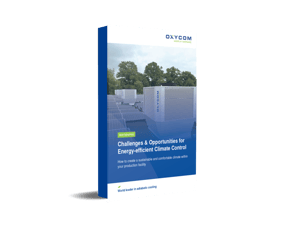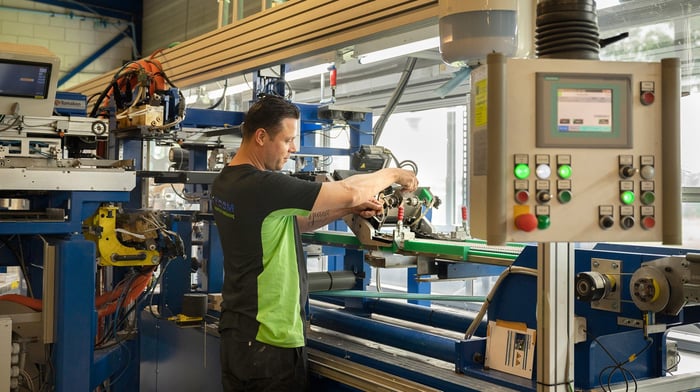Productive employees are essential to keep a business running. They are the key to the success and longevity of the company. The work environment has a major impact on employee productivity. A good work environment should be inspiring and provide sufficient space to move for every employee. As an employer, you can anticipate this. But how do you create a productive work environment? In this blog, we share five tips you can apply to increase productivity in the workplace.
Tip #1: Ergonomic workplace
In production departments, people and machines work together to perform a task. Optimization of this cooperation is important to increase production and make it more efficient. Ergonomics in the workplace is a focus point to optimize the production output. In fact, companies with little attention to an ergonomic work environment are more likely to suffer from workplace physical ailments, high absenteeism, and lower productivity. Does this sound familiar to you?
The right ergonomic tools and conditions ensure optimal productivity of employees. In production, an ergonomic workplace is a place where employees have to lift as little as possible. Sometimes lifting is unavoidable, but try to limit the burden as much as possible. The European standard for the general work population is 24 kilograms under the right circumstances and the weight should be lifted close to the body at hip height. When it comes to relocating things, ergonomic means of transport such as a conveyor belt or a lifting system help to minimize the strain on the body. Besides the above, there are many more options that help create a comfortable workspace to achieve better concentration and higher productivity.
Tip #2: Acoustics
A common problem in a production hall or workshop is poor acoustics. Production work is often done with a variety of machines, some of which make earsplitting noises. In addition, production areas are usually constructed with hard materials such as steel, concrete, and glass. These noise sources create a high noise level with a lot of reverberation that negatively affects the concentration of employees. This continuous noise nuisance results in stress and fatigue, poor productivity, and frequent mistakes in the long term.
The provision of earmuffs or earplugs is a quick fix to reduce noise nuisance. Another option is to improve acoustics, which is at the core of the problem. For industrial environments such as factories and workshops, using different base materials is a simple way to make improvements. Practical solutions include the use of acoustic ceiling panels, wall panels, or baffles. The latter, in particular, are acoustic elements primarily used in the industry. Baffles are acoustic boards that are suspended vertically from the ceiling to intercept sound waves. The noise level decreases and creates a more comfortable working environment.
Tip #3: Daylight
The combination of direct and indirect light must be balanced in every production facility, especially since people depend on natural daylight and sunlight. Sunlight, in particular, has a positive influence on motivation and therefore increases productivity. In addition, light has a huge influence on our biological clock and thus our energy level in which we are either sleepy or alert. However, there is also a downside to sunlight, one that many production halls and distribution centers experience in summer. In the summer, more direct sunlight falls perpendicular to the earth. This causes a surface to heat up much faster than in the winter when solar rays hit the earth at an angle. Therefore, the heat from direct sunlight during the summer increases indoor temperatures the most.
Buildings with many windows or that are located in direct sunlight see indoor temperatures rise on a hot and sunny summer day. This has a negative effect on the productivity of employees. They are more likely to stand still to take a break from the heat. To prevent direct sunlight from entering the factory hall, solar shading is a good solution. Awnings and blinds are suitable options that repel heat during sunny days. The indoor temperature will then remain cool for longer and only rise slightly. During cloudy and winter days, solar shading can be rolled up to allow workers to enjoy natural daylight.
Tip #4: Temperature
Many production halls operate with a varying number of production machines. These running machines and production processes release a lot of heat, resulting in high indoor temperatures. The working climate becomes even more unbearable when temperatures rise in summer. Heat, both indoors and outdoors, has a major effect on the human body. The body temperature rises and the combination of heat and lack of moisture results in heat stress. Heat stress causes health problems, such as heat strokes, fainting, cramps, and dehydration. The ability to concentrate also decreases, which is harmful to the product quality.
In short, a high indoor temperature affects the health of employees, leading to increased absenteeism. It is therefore disadvantageous for a productive work environment. Scientific research shows that with every degree above 20, concentration levels drop by 2%. This can make a huge difference in production areas, where no or a poorly working climate system is present. An optimal working climate system ideally maintains a constant temperature of around 18℃. This temperature creates a healthy and productive work environment.
Tip #5: Ventilation
The air quality in the workplace often differs greatly from the outdoor air. In production facilities, the indoor climate is worsened by dust, gases, and vapors released in the production process. In addition, the presence of people causes an increase in condensation through moisture released via breathing and sweating. This moist and polluted air needs to be extracted from the building. Condensed moisture is in fact the spreader of fungi, bacteria, and viruses, which affects the health of employees. Polluted air can lead to a wide range of health problems such as asthma, irritation, and allergic reactions. The lack of oxygen in polluted air also causes severe headaches and a decrease in concentration.
Poor air quality in the work environment strongly influences the health and work productivity of employees. It can even ultimately affect the quality of products. Therefore, it is important to replace polluted air with fresh air. The best solution for this is to ventilate with clean outside air. Ventilation ensures a continuous supply of new oxygen-rich air. This creates a pleasant indoor climate with humidity between 40 and 70%. Ventilation of production areas is therefore the best solution to create a comfortable indoor temperature with sufficient humidity, which benefits the health of employees and the labor productivity.
Oxycom's evaporative climate solutions
For many production facilities, finding appropriate ventilation and cooling systems is a challenge. As a result, the use of effective ventilation is currently rather mediocre in the industry.
Oxycom can help you solve this. Our highly innovative natural cooling systems cool and ventilate buildings with fresh outdoor air. In addition, Oxycom’s patented indirect/direct adiabatic cooling technology regulates the indoor temperature and maintains the humidity. We can offer you a constant temperature around 18°C with a humidity between 40 and 70%. This combination is the key to a comfortable and healthy indoor environment. Moreover, the resulting pleasant work environment benefits the health of employees and boosts productivity. Even during hot summer days.
 Download our whitepaper “Challenges and Opportunities for Energy-Efficient Climate Control”, and discover how you can create a comfortable and sustainable indoor climate within your production facility.
Download our whitepaper “Challenges and Opportunities for Energy-Efficient Climate Control”, and discover how you can create a comfortable and sustainable indoor climate within your production facility.
If you would like to know more about our two-stage evaporative technology solution, please contact us at +31 572 349 400, or fill in the form directly with your question:





